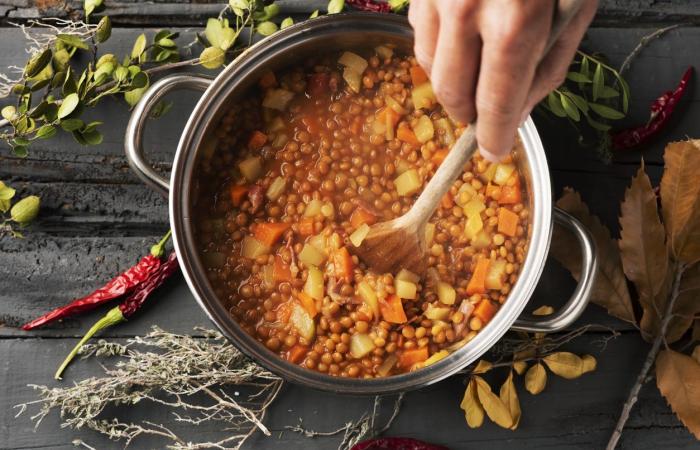Why is magnesium essential to face winter well?
Before discovering which foods to choose, it is essential to understand why magnesium is so valuable. This mineral participates in many vital functions in our body. It plays a key role in muscle relaxation, nervous system function and energy production. This is why a deficiency can quickly result in fatigue, muscle cramps or even a feeling of irritability and nervousness.
In winter, the lack of sunlight and shorter days increase our need for magnesium, and this deficit is common. The recommended daily intakes are 360 mg for women and 420 mg for men. By favoring certain foods, you can easily achieve these intakes and maintain a good energy level all season long.
Green leafy vegetables: a concentrate of magnesium on your plate
Green leafy vegetableslike spinach and chard, are excellent for stocking up on magnesium. In fact, 100 g of cooked spinach provides around 80 mg of magnesium. And, good news, they are in season during the winter!
How do they integrate?
Spinach and chard lend themselves to many recipes: gratins, soups, or even quiches. To make the most of their benefits, eat them cooked, as their reduced volume makes it easier to eat a good quantity. Add a touch of cream for a comforting effect or a little grated cheese to please the whole family.
Legumes: the energy ally of your winter dishes
Legumes like lentils, chickpeas and beans are not only rich in magnesium, but also in protein and fiber. Perfect for substantial meals, they provide between 40 and 60 mg of magnesium per 100 g.
How do they integrate?
Legumes are ideal for slow-cooked winter dishes: vegetarian chili, stews, curries or even the traditional lentil savory dish. You can also prepare warm lentil salads, with nuts and winter vegetables to vary the pleasures while enjoying their energy benefits.
Nuts: an energizing snack to fight fatigue
Walnuts, almonds, hazelnuts, pistachios… These nuts are perfect for a quick and natural supply of magnesium. With an average of 130 mg of magnesium per 100 g, they help maintain stable energy throughout the day and are easy to consume as a snack.
How do they integrate?
Keep a handful of nuts or almonds on hand for your little cravings, or add them to your dishes and salads for a crunchy side. Nuts can also be used in desserts: mixed into yogurt or sprinkled on porridge for breakfast.
However, be careful with the quantities, because they are caloric; a handful is enough to fill a need while remaining balanced.
Dark chocolate: a pleasure that boosts magnesium and morale
The dark chocolatein addition to being delicious, is an unsuspected source of magnesium. The higher its cocoa content, the richer it is in magnesium, with around 100 mg per 100 g of 70% cocoa chocolate. Something to treat yourself while contributing to your magnesium intake.
How to integrate it ?
A square of dark chocolate at the end of a meal or as a snack is ideal for providing magnesium while delighting the taste buds. If you prefer, you can incorporate it into a light cake recipe or a hot chocolate for a delicious and revitalizing break. Choose bars with a cocoa content of at least 70% to benefit from the best nutritional benefits.
Bananas: the energetic fruit not to be underestimated
Finally, the bananas are another valuable source of magnesium, while being easy to consume at any time of the day. A medium banana contains around 30 mg of magnesium, in addition to being rich in potassium and vitamin B6, nutrients perfect for boosting your energy and promoting a good mood.
How do they integrate?
Bananas are convenient to eat as is, but they also lend themselves to a variety of recipes. You can add them to a smoothie, stir them into a warm breakfast porridge, or even lightly cook them with a pinch of cinnamon for a quick and healthy dessert.
The 5 rich foods in magnesium for winter
| Aliment | Amount of magnesium (per 100 g) | Integration idea |
|---|---|---|
| Spinach and chard | 80 mg | Gratin, quiche, soup |
| Lentils and chickpeas | 40-60 mg | Chili, stew, curry |
| Walnuts and almonds | 130 mg | As a snack, in salads |
| Dark chocolate (70% cocoa) | 100 mg | After-meal square, hot chocolate |
| Bananas | 30 mg | Snack, smoothie, porridge |
Integrate these foods into your daily life: simple actions for better energy
Eating more magnesium in winter does not require revolutionizing your diet. By integrating these five foods regularly, you will contribute to meet your magnesium needswhile enjoying varied and tasty dishes. You will feel the benefits on your energy level, your morale and even on the quality of your sleep.
Winter can be a demanding season for our body, but with these foods rich in magnesium, you have all the keys in hand to get through this period without excessive fatigue. So why not adapt your meals today to take full advantage of the benefits of this essential mineral?







